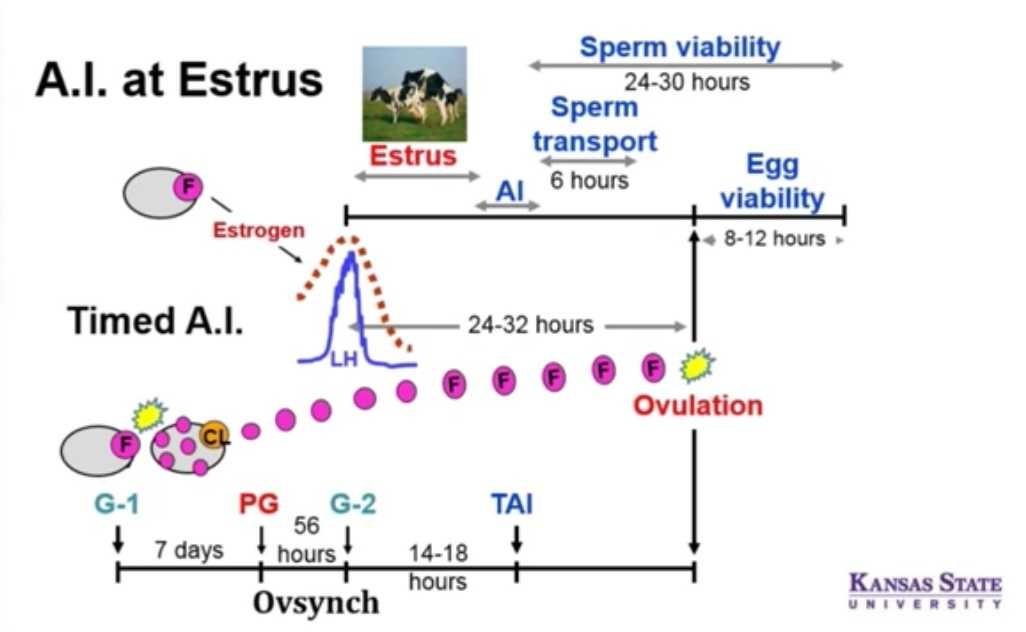A.I. at Estrus and Timed A.I. - a comparison of the timing of events
A.I. at Estrus and Timed A.I. - a comparison of the timing of events
Proper timing of insemination results in live capacitated sperm cells being in the oviduct to meet the newly ovulated oocyte. This can be accomplished with A.I. after standing estrus or timed A.I. at the end of a simple ovulation synchronization protocol.

Our visual aid will be this excellent figure from Dr. Jeff Stevenson of Kansas State University. The top portion shows the events and their timing if we A.I. at estrus and the bottom portion shows the timing of those events with the Ovsynch timed A.I. protocol. As we discuss each event, we will discuss what goes on in the A.I. after standing estrus scenario first.
Dominant follicle and estrogen
Follicles in the cycling cow are always growing and regressing. In the days just before the cow is in standing heat there is one large dominant follicle which is the follicle that ovulates in that estrous cycle. This follicle produces a high level of estrogen which results in the animal exhibiting standing heat.
The first step of Ovsynch is a GnRH shot (G-1). The GnRH stimulates a surge of Luteinizing Hormone (LH) which ovulates the dominant follicle present at the time and starts a new follicular wave. The dominant follicle from this wave is the follicle that ovulates after the timed A.I. The estrogen level also rises with this follicular wave, but the cow does not come in heat because there is circulating progesterone. She can have one CL or two CLs. If the Ovsynch is started late in the estrous cycle, she will have one CL from the ovulation of the dominant follicle after the G-1 shot. If Ovsynch is started in the early part of an estrous cycle, she will have two CLs (one from the CL present at the time Ovsynch starts and the new CL).
Prostaglandin
Prostaglandin F2alpha (PG) regresses the CL. PG is released from the uterus at about cycle day 16 if the cow is not pregnant. This zaps the CL and circulating levels of progesterone drop quickly. With the progesterone low and estrogen high, the cow comes into standing heat at the appropriate time.
The Ovsynch PG is given on protocol day 7 and kills the CL or CLs. Progesterone levels drop rapidly, but the cow doesn't exhibit estrus because the G-2 shot has signaled the dominant follicle to shift gears from producing estrogen to preparing for ovulation.
Luteinizing Hormone (LH)
LH is the hormone which signals the dominant follicle to prepare for ovulation. In the cycling cow there is a big release of LH at the start of standing heat which we call the LH Surge.
In Ovsynch the G-2 shot results in an LH Surge.
Ovulation
Ovulation occurs 28 hours after the LH Surge on average. So, the cycling cow ovulates about 28 hours after the start of standing heat. The cow on the Ovsynch protocol ovulates about 28 hours after G-2.
When to inseminate
As stated earlier, proper timing of insemination results in having live capacitated sperm cells in the oviduct to meet the newly ovulated oocyte. A high percentage of sperm cells are viable for 24-30 hours after insemination. Capacitation is a process sperm cells must undergo inside the cow's reproductive tract before they can fertilize the oocyte. Sperm transport and capacitation take 6 hours. So, if we inseminate at least 6 hours before ovulation, but not longer than 24 hours before ovulation we have accomplished our goal. Breeding using the a.m.-p.m. rule for cows seen in heat or 14-18 hours after G-2 of the Ovsynch protocol both result in insemination at the correct time.
Author: George Heersche
